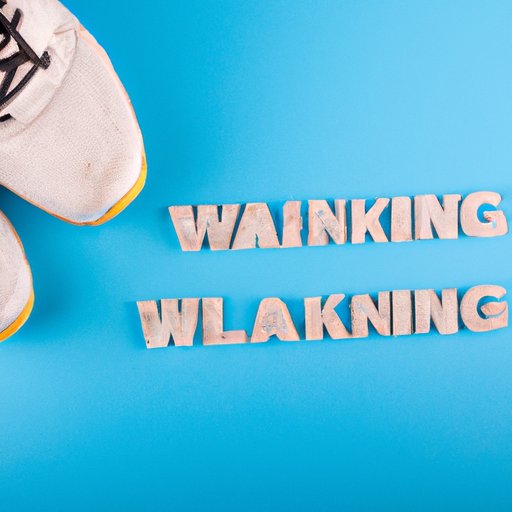
I. Introduction
For many people, weight loss can be a struggle. It’s hard to know where to start, and what will be most effective for your body. The good news is that one simple and easy way to begin losing weight is by walking. Walking is an activity that almost anyone can do and is an excellent way to increase physical activity levels. In this article, we’ll explore the benefits of walking for weight loss, how long you should walk each week, and other tips and tricks to help you on your journey to a healthy weight.
II. The benefits of walking for weight loss and the science behind it
Walking is one of the easiest and most accessible forms of exercise, but it can be highly effective for weight loss. Walking can burn calories, help to boost metabolism, and decrease stress levels. According to one study, walking for 30 minutes a day can significantly reduce the risk of obesity, high blood pressure, type 2 diabetes, and heart disease. This is because walking can help our bodies to regulate blood sugar levels, lower blood pressure, and decrease levels of harmful cholesterol.
When we walk, we engage all the major muscle groups in the body, which helps to boost metabolism. This means that even after we stop walking, our body continues to burn calories at a higher rate. According to the American Council on Exercise, the average person can burn around 200 to 300 calories per hour of walking, depending on their weight and walking speed.
III. Recommended amount of walking per week for optimal weight loss and how to track it
So, how much should you be walking each week to lose weight effectively? The American Heart Association recommends that adults get at least 150 minutes of moderate-intensity aerobic activity every week, which can include walking. This works out to be around 30 minutes of walking, five days a week. However, walking for longer or more often can help to increase the amount of weight that you lose, provided that you’re not overeating to make up for the extra calories burned.
It can be helpful to track your walking progress using a fitness tracker or pedometer. These devices can help you to set goals and monitor your progress over time. You can also track your walking progress using free apps like MapMyWalk or Strava.
IV. Tips for integrating walking into daily routine for those with busy schedules
If you have a busy schedule, finding time to walk can be a challenge. But there are ways to integrate walking into your daily routine, even if you don’t have time for a dedicated workout. One way is to try walking to and from work or school. If you take public transportation, consider getting off a stop early and walking the rest of the way. You can also try walking during your lunch break, or squeezing in a quick 10-minute walk during breaks throughout the day.
Other creative ways to increase physical activity include taking the stairs instead of the elevator, parking farther away from your destination, or going for a walk with your family or friends after dinner. These small changes can all add up to increase your daily physical activity levels.

V. Best time of day to walk to maximize weight loss and energy levels
When it comes to walking for weight loss, the time of day can make a difference. Walking in the morning can help to boost metabolism and energy levels, and studies have shown that morning exercisers are more likely to stick to their workout routine. On the other hand, walking later in the day can help to reduce stress levels and improve sleep quality.
Ultimately, the best time of day to walk is the time that works best for you. If you’re not a morning person, a later afternoon or evening walk might be a better fit for your schedule and energy levels.
VI. Importance of proper posture and form during walks to avoid injury and increase results
When you’re walking for weight loss, it’s essential to maintain proper posture and form. This can help to reduce the risk of injury and increase the effectiveness of your workout. Proper walking posture involves standing up straight, engaging your core, swinging your arms naturally, and taking small steps.
To maintain proper form while walking, it can be helpful to focus on your breathing. Take deep breaths in through your nose and exhale through your mouth. Engage your core muscles and stand up straight, keeping your shoulders relaxed and your elbows bent at a 90-degree angle. Focus on taking short, quick steps and swinging your arms naturally at your sides.
VII. Alternative methods to increase walking intensity such as interval training or incline walking
If you’re looking to increase the intensity of your walking workouts, there are a few ways to do so. One way is to try interval training, which involves alternating between periods of high-intensity walking and recovery periods of lower intensity. Another option is to walk on an incline, which can help to boost the calorie-burning effects of your walk and work different muscle groups in the legs and glutes.
You can also combine interval training with incline walking for an even more challenging workout. For example, you could try walking on an incline for five minutes, then switching to flat ground for one minute of high-intensity walking, then repeating the cycle for 30 minutes.
VIII. How to stay motivated and accountable when committing to a walking routine for weight loss
Staying motivated and accountable can be a challenge when it comes to any workout routine. To help stay motivated, try setting specific goals for yourself, like walking a certain number of steps each day or completing a specific walking workout each week. It can also be helpful to find a workout buddy or join a walking group, so you have someone to hold you accountable and provide motivation.
Remember to be patient with yourself and celebrate your progress along the way. Weight loss is a journey, and every step counts. Don’t be too hard on yourself if you miss a workout or have a setback. Instead, focus on getting back on track and making progress towards your goals.
IX. Conclusion
Walking is a simple and effective way to start losing weight and improving your overall health. By walking for at least 30 minutes a day, five days a week, you can significantly reduce your risk of obesity, heart disease, and other chronic illnesses. By focusing on proper form, tracking your progress, and staying motivated, you can make walking a regular part of your healthy lifestyle.




